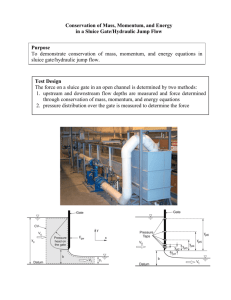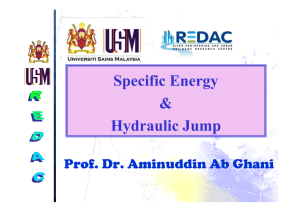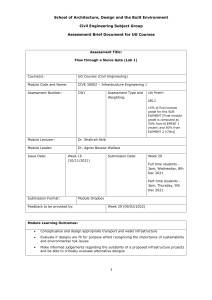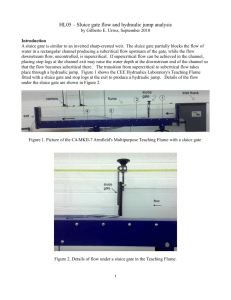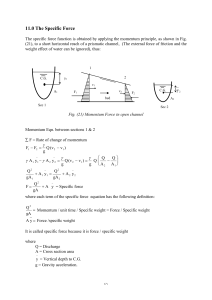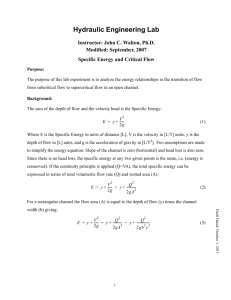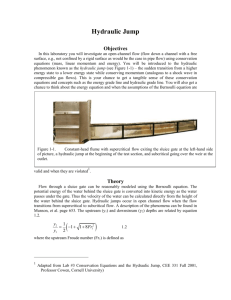Virginia Polytechnic Institute and State University
advertisement
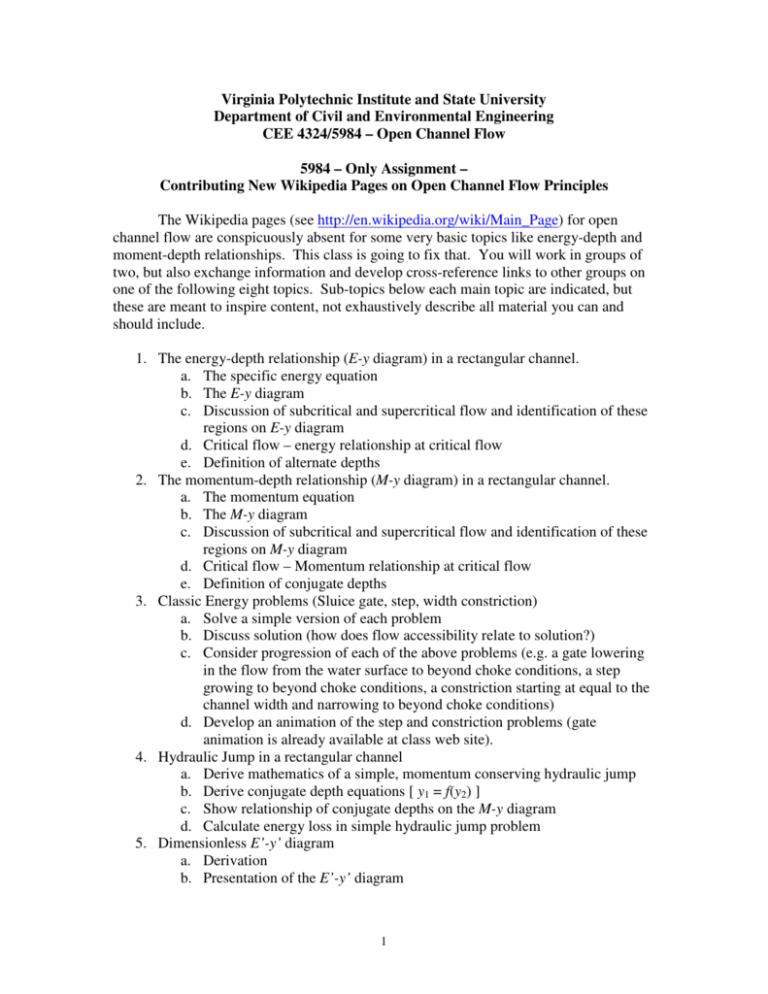
Virginia Polytechnic Institute and State University Department of Civil and Environmental Engineering CEE 4324/5984 – Open Channel Flow 5984 – Only Assignment – Contributing New Wikipedia Pages on Open Channel Flow Principles The Wikipedia pages (see http://en.wikipedia.org/wiki/Main_Page) for open channel flow are conspicuously absent for some very basic topics like energy-depth and moment-depth relationships. This class is going to fix that. You will work in groups of two, but also exchange information and develop cross-reference links to other groups on one of the following eight topics. Sub-topics below each main topic are indicated, but these are meant to inspire content, not exhaustively describe all material you can and should include. 1. The energy-depth relationship (E-y diagram) in a rectangular channel. a. The specific energy equation b. The E-y diagram c. Discussion of subcritical and supercritical flow and identification of these regions on E-y diagram d. Critical flow – energy relationship at critical flow e. Definition of alternate depths 2. The momentum-depth relationship (M-y diagram) in a rectangular channel. a. The momentum equation b. The M-y diagram c. Discussion of subcritical and supercritical flow and identification of these regions on M-y diagram d. Critical flow – Momentum relationship at critical flow e. Definition of conjugate depths 3. Classic Energy problems (Sluice gate, step, width constriction) a. Solve a simple version of each problem b. Discuss solution (how does flow accessibility relate to solution?) c. Consider progression of each of the above problems (e.g. a gate lowering in the flow from the water surface to beyond choke conditions, a step growing to beyond choke conditions, a constriction starting at equal to the channel width and narrowing to beyond choke conditions) d. Develop an animation of the step and constriction problems (gate animation is already available at class web site). 4. Hydraulic Jump in a rectangular channel a. Derive mathematics of a simple, momentum conserving hydraulic jump b. Derive conjugate depth equations [ y1 = f(y2) ] c. Show relationship of conjugate depths on the M-y diagram d. Calculate energy loss in simple hydraulic jump problem 5. Dimensionless E’-y’ diagram a. Derivation b. Presentation of the E’-y’ diagram 1 c. Discussion of characteristics at critical depth d. Solution of simple example of sluice gate problem (see #3 above) with dimensionless diagram 6. Dimensionless M’-y’ diagram a. Derivation b. Presentation of the M’-y’ diagram c. Discussion of characteristics at critical depth d. Solution of simple version of hydraulic jump with dimensionless diagram 7. Dimensionless E-y and M-y diagram duality a. Derive duality relationship b. Using dimensionless E’-y’ only, solve simple sluice gate problem (see #3 above) followed by an immediate hydraulic jump. i. Calculate all relevant depths, energies, momenta based on E’-y’ diagram alone. Calculate momentum lost at gate. Calculate energy lost in jump. c. Using dimensionless M’-y’ only, solve simple sluice gate problem (see #3 above) followed by an immediate hydraulic jump. i. Calculate all relevant depths, energies, momenta based on M’-y’ diagram alone. Calculate momentum lost at gate. Calculate energy lost in jump. 8. Derivation of Alternate Depth relationship [ y1 = f(y2) ] a. Start from conjugate depth relationships derived in #4 above b. Use duality concept from #7 above to derive analytical alternate depth relationship (Note: this is a real contribution. To the best of teacher’s knowledge, this relationship is not published in any book). Relevant Dates: • September 2: Formation of groups, and problem preference conveyed to teacher. Each group conveys URL for their problem (can be at Scholar, but must be publicly viewable). • September 9: Problem assignments announced by teacher. • September 23: Outline of report submitted to teacher. (10 points) • October 7: Draft of report submitted to teacher. (20 points) • October 14: Teacher returns draft reports. • October 28: Final written report submitted to teacher. (50 points) • November 4: Teach returns graded final reports with any needed modifications indicated. • November 11: Wikipedia pages completely constructed reflecting all content in final report and modifications as indicated (15 points). • November 18: Teacher returns review of Wiki pages. • November 30: Final revised Wikipedia pages appear (5 points). 2
